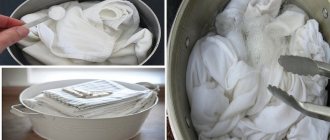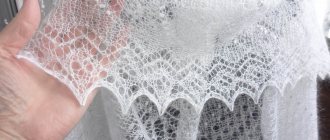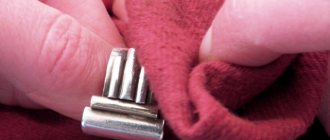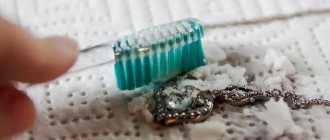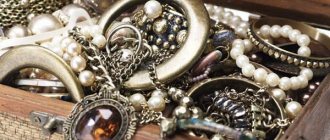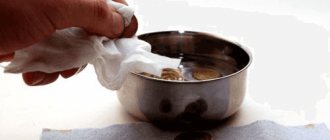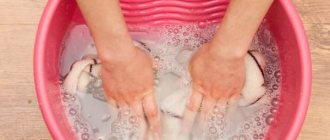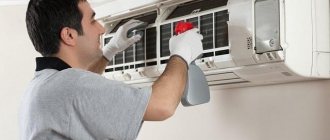Icer Tried all cleaning methods
I have some silver jewelry that I stopped wearing a couple of years ago because it tarnished. A week ago I came across a chain and decided to see if it was possible to return it to its original appearance.
After cleaning silver using any of the described methods, rinse it thoroughly with clean water.
I read the advice of jewelers and manufacturers and came to the conclusion that the best way to clean silver is with ammonia and peroxide. I'll tell you how to do the work.
How to properly clean silver items
Cleaning silver at home can cause irreparable damage to the product, so you should adhere to several rules:
- You should only use sponge, wool or soft fabrics that cannot scratch the product.
- To prevent black deposits, silver items must be cleaned regularly.
- Particular attention should be paid to jewelry with natural stones or antique collectibles. It is best to give them to professionals, because ammonia in small overdoses can harm silver.
- After cleaning, the products must be dried at room temperature or with a hair dryer.
- Storing silver items requires separate boxes or cabinets.
- When going to the bathhouse or shower, remove chains and rings.
You need to take care of silver items regularly and carefully, then they will last a long time, maintaining their original appearance. If decorations or cutlery are not used for a long time, they should be wrapped in foil and stored in a dry place. This storage method prevents the appearance of oxides on the surface of the silver.
How silver behaves with ammonia - advice from the pros when cleaning jewelry
Blackened pieces of jewelry spoil the mood: money seems to have been thrown away, but I really wanted to wear the item longer. Is it possible to “reanimate” a blackened product that cannot be cleaned using conventional methods?
Jewelers know that cleaning silver with ammonia is a completely acceptable technique when it comes to caring for silver items. Ammonia is one of the cheapest, and most importantly effective, ways to clean jewelry from blackness. Why does this nuisance accompany jewelry in general? Is it possible to avoid it?
Causes of blackness in silver
Silver earrings, rings or bracelets require more care compared to their “brother” – gold. Gold products need attention once a year, silver - twice every 60 days. Blackness affects especially often and too strongly those products that are made of poor quality. The main reason for the unpleasant effect that provokes the search for a cleansing technique is the addition of impurities during production. A large amount of ligature leads to blackening.
Air is no less important for silver. The presence of sulfur in it also leads to sad consequences. When purchasing, giving preference to 925 sterling silver, you often won’t have to think about how to clean silver with ammonia. This option is characterized by its resistant nature to the composition of air masses. Rhodium plating will completely extend the service life without making you think about the topic of darkening.
Behavior of silver in ammonia solution
Precious metal belongs to the category of malleable to different cleaning methods. Cleaning silver with ammonia will only benefit silver jewelry: alcohol will return it to its former style and impeccable appearance. Ammonia can react with any oxidizing agent, so it serves as an excellent solvent. Its use is justified by its harmless effect on the metal. You need to remember some rules when starting the cleaning method.
Behavior of silver in ammonia solution
Care must be taken when caring for silver.
Silver and gold items should not be placed in the same container with ammonia. You need to work with the product in a well-ventilated area. Do not allow it to come into contact with the skin or mucous membranes. It is better not to clean cutlery with them: incompletely washed cutlery that retains the smallest food residues along with ammonia will enter the stomach, causing tissue burns. In any case, safety precautions must be observed. Cleaning silver with ammonia
Other cleaning methods
There are many other methods for cleaning silver. These include:
- Egg yolk. Soak a cotton pad in it and rub the product, then let it dry a little and rinse it off.
- Vinegar. Polish the silver with the product for several minutes using a brush or sponge. The vinegar needs to be heated a little first.
- Kefir. Place the decoration in a container with sour milk and leave for 2 hours, then rinse well.
Lemon acid. The product is dissolved in water and simmered in a water bath. They also put a small piece of copper wire and a silver decoration there. Boil for 20 minutes. Wash the silver under running water.- Coca Cola. It is recommended to boil silver in the drink for 10 minutes.
An original way to remove dirt from silver is to clean it with lipstick. Rub the item well with it, then wash it off.
The following methods will also help to give your jewelry a new shine:
- soaking in sour milk;
- rubbing with vinegar;
- polishing with soap mixture;
- soaking in vinegar-soda solution.
After cleaning, you can wash your products not only in plain water; it’s good to add 2 drops of Ferry to it.
What not to do
Do not use any abrasives to clean silver. Baking soda or powder will scratch the product. Silver is a fairly soft metal. Also, do not throw silver items anywhere, but put them in a wooden box upholstered with fabric.
Silver darkens from contact with various substances: onions, salt, some foods and chemicals. Therefore, be sure to remove your silver rings when cooking or cleaning your home.
You should also not use any cosmetics without removing your silver earrings or chain. Reactions to creams containing various substances can be disastrous. Is your product precious to you?
It is also not recommended to wear silver jewelry in the sauna. The evaporation from your body will remain in the form of microparticles that will fill the voids. The product will look untidy.
You should not swim in chains - the steel spring will quickly rust and the lock will break. This way you risk losing the product altogether.
Additional types of cleaning
If your product is very dirty and you cannot do without rough mechanical cleaning, you have two options. The first is that you can go to a jeweler and ask him to provide a service according to his profile. The second is to clean the product at home.
Tooth powder is an excellent tool for cleaning silver items. It is soft enough and does not leave marks. It can be added to a solution of ammonia in the volume of the latter. That is, for 10 parts water, 4 parts alcohol and 4 parts powder.
Deep cleaning of silver is performed using sodium thiosulfate. This substance is used to separate silver from ore on an industrial scale. There are analogues of it in the pharmacy or hardware store - photographic sodium hyposulfate. We dilute the substance in water 2/10 and rinse after mechanical cleaning with a toothbrush and tooth powder.
Rules for caring for silver
To prevent silver from darkening, the following rules should be followed:
- Put on jewelry only after the cosmetic oil or cream has been completely absorbed.
- Avoid storing silver in high humidity conditions.
- Remove jewelry when swimming, especially in salt water.
- It is advisable to store the products in a dry place; it is best to wrap them in foil.
- Remove chains and rings before dishwashing or hand washing.
- To prevent silver from oxidizing, it is recommended to place aluminum foil in the box.
- You can put chalk in the storage box to help maintain the shine.
- After removal, it is recommended to wipe the jewelry with a soft, dry cloth.
It is also important to periodically clean silver from plaque.
If you follow these recommendations, you can wear the jewelry longer, because it will turn black less.
How to clean silver with ammonia
Compared to other cleaning agents, ammonia is more aggressive. Therefore, it is allowed to use the described methods using personal protective equipment.
An effective method for cleaning cutlery
To clean silver cutlery from black plaque, use a mixture of ammonia and chalk or tooth powder. Both components must be mixed to a porridge-like substance, then applied to the product and left for 20 minutes. After this, you need to rinse the silver under water.
Cutlery is constantly in contact with mucous membranes. Therefore, it is recommended to rinse products after cleaning at least twice.
At the end of the procedure, cutlery should be wiped with a dry cloth, paying attention to hard-to-reach places. The latter can be cleaned using cotton wool wrapped around a needle (sharpened match).
How to Clean Silverware
Recipe for cleaning large items
If there is a need to clean large objects made of silver (cups, decorative elements on furniture, etc.), then a mixture of water, ammonia and tooth powder taken in a ratio of 5:2:1 will help. You need to moisten a cotton pad in the resulting solution and wipe the contaminated items with it.
If objects that come into contact with children or animals are trimmed with silver, the product must be washed with clean water after the procedure.
Due to oxidation, which causes the appearance of a black coating, the metal loses its original shine. Therefore, after cleaning, silver is re-treated with appropriate products.
Methods for cleaning silver with ammonia
When compared with many other chemical solutions for removing stains, cleaning silver with ammonia has its own definite advantages. The effect is achieved due to the properties of the substance - it is volatile in the air, dissolves in water, and the remaining particles affect the metal, or more precisely, the substances that oxidize it. During exposure, the silver remains undamaged.
There are several ways to clean silver with ammonia at home.
Method one:
- Find a container that will hold the silver items you are cleaning.
- Pour cold water and ammonia in a ratio of 10:1.
- Immerse the product in the resulting solution and leave for half an hour. If severe contamination is observed and this time is not enough, increase the time by another 20-30 minutes.
- Remove and wipe the silver with a clean sponge
- Dry the cleaned items.
If your jewelry contains precious stones, especially pearls, you should not soak them in this solution. For cleaning, you should choose another option.
Method two
For minor darkening, do not completely soak the silver in ammonia. It is enough to moisten a woolen napkin in the substance and rub it in contaminated areas.
Method three
If the above methods do not help remove tarnish from silver, try combining ammonia with tooth powder according to the instructions:
- Make a mixture of 5 parts warm water, 1 part powder and 2 parts alcohol.
- Soak a soft cloth in the resulting mixture and treat the darkened areas.
- Rinse off the applied mixture with water.
- Wipe with a dry cloth.
This cleaning method is also suitable for items decorated with stones.
Method four
Ammonia in combination with liquid soap helps to clean silver:
- It is necessary to take both components in equal shares.
- Mix them with water.
- Immerse the items to be cleaned in the resulting solution for 30-40 minutes.
- When the darkening disappears, wipe the silver with a dry cloth.
